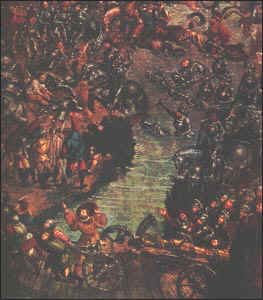
Bratslav fortress

 |
Bratslav fortress |
 |
Bratslav fortress was the center of the
historic events for a rather long period of time. It was a sort of symbol of the struggle
for the Eastern  Podillia. That struggle began in the middle of the
XIVth century when the forces of Olgerd came there and it lasted for some centuries.
Olgerd’s nephews the princes Koriatoviches ordered to built castles on Podolian land and
one of the first was ordered to be built on the bank of the Bug. It was named Briaslavl
(Bratslav). That was at the beginning of 60’s of the XIV century. In some years another
Lithuanian prince Vitovt took Bratslav castle away from the Koriatoviches and appointed a
new Head of the town. In 1432 (another date is 1434) Bratslav became part of the Polish
Kingdom but it was returned to Lithuania in 40’s of the XVth century. Beginning from the
end of XVth century Bratslav fortress became the epicenter of the military actions in the
Eastern Podillia. In 1479 “Tatars did much harm to Podillia and near Bratslav.” As a
result of it the castle burnt away. Soon the great province Olexander Yagellonchik
Podillia. That struggle began in the middle of the
XIVth century when the forces of Olgerd came there and it lasted for some centuries.
Olgerd’s nephews the princes Koriatoviches ordered to built castles on Podolian land and
one of the first was ordered to be built on the bank of the Bug. It was named Briaslavl
(Bratslav). That was at the beginning of 60’s of the XIV century. In some years another
Lithuanian prince Vitovt took Bratslav castle away from the Koriatoviches and appointed a
new Head of the town. In 1432 (another date is 1434) Bratslav became part of the Polish
Kingdom but it was returned to Lithuania in 40’s of the XVth century. Beginning from the
end of XVth century Bratslav fortress became the epicenter of the military actions in the
Eastern Podillia. In 1479 “Tatars did much harm to Podillia and near Bratslav.” As a
result of it the castle burnt away. Soon the great province Olexander Yagellonchik ordered
to reconstruct castle. Bratslav was renamed into the town of St. Peter-apostle. The
picture of St. Peter was in the first version of the coat of arms of the town (that name
didn’t acclimatize). Bratslav castle was not big, it was badly fortified and equipped.
In the case of necessity it could hold not more than a third of the population and the
roads to the castle were not well done. A state inspector noticed that in 1545 the castle
was reinforced. But at that time only a fortress could save the situation. Tatar hordes
appeared regularly near Bratslav and attacked it by storm. One of the most famous attacks
was the attack made by Crimean Khan Davlet-Girey (“Tsar of Perekop” – he was called
in chronicles) in 1551. The town and the castle were occupied because of the deputy Bogdan
Slupitsa. A modern historian writes about this: “There left
only ruins of the rich town and
only 200 people from the densely populated suburb could survive. In 1569 Bratslavshchina
became part of Rich Pospolita as a province and Bratslav itself got the Magdeburg Right.
In 1594 Severin Nalivayko’s rebels attacked the camp of the Polish gentry near the
Bratslav castle. The rebels were supported by the local leader Roman Tishkevich and many
Polish “administrators” were killed. In four years Bratslav wasn’t already the
center of the province. It was in Vinnitsa. Bratslav castle played a great role in the
years of Liberation War and Ruina. It is impossible to name all historic and public
figures connected with the history of the castle at that time. Among them are: hetmans
Ivan Vigovskiy, Uriy Khmelnitskiy, Pavlo Teteria, Petro Doroshenko, colonel Danilo Nechay,
commander of Cossack camp Ivan Sirko, Moldavian manager Duka and many other. According to
interstate agreement of the second half of the XVII century the major part of
Bratslavshchina had not to be populated. Castle fortification of Bratslav fell into decay.
They were going to reconstruct Bratslav castle in the XIXth century after the order of
Mikola I. Bratslav was on the intersection of strategic roads and the emperor was
interested in that. In 1832 there was made a plan of a future castle but the project was
not realized. Nowadays nothing has left from the old castle.
![]()